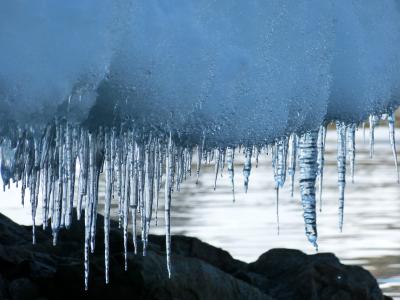Antarctic sea-level rising faster than global rate

Icicles are formed by the melting of a glacier in west Antarctica. The melt here is rapid and has been accelerating, injecting greater quantities of freshwater into the ocean and raising sea levels. Credit: Mike Meredith
Researchers at the University of Southampton detected the rapid rise in sea-level by studying satellite scans of a region that spans more than a million square kilometres.
The melting of the Antarctic ice sheet and the thinning of floating ice shelves has contributed an excess of around 350 gigatonnes of freshwater to the surrounding ocean. This has led to a reduction in the salinity of the surrounding oceans that has been corroborated by ship-based studies of the water.
“Freshwater is less dense than salt water and so in regions where an excess of freshwater has accumulated we expect a localised rise in sea level,” says Craig Rye, lead author of the paper that has been published in the journal Nature Geoscience.
In addition to satellite observations, the researchers also conducted computer simulations of the effect of melting glaciers on the Antarctic Ocean. The results of the simulation closely mirrored the real-world picture presented by the satellite data.
“The computer model supports our theory that the sea-level rise we see in our satellite data is almost entirely caused by freshening (a reduction in the salinity of the water) from the melting of the ice sheet and its fringing ice shelves,” says Craig.
“The interaction between air, sea and ice in these seas is central to the stability of the Antarctic Ice Sheet and global sea levels, as well as other environmental processes, such as the generation of Antarctic bottom water, which cools and ventilates much of the global ocean abyss.”
The research was carried out in close collaboration with researchers at the National Oceanography Centre and the British Antarctic Survey.
Notes to editors
1. Picture: Icicles formed by the melting of a glacier in west Antarctica. The melt here is rapid and has been accelerating, injecting greater quantities of freshwater into the ocean and raising sea levels. Credit: Mike Meredith
High-res version available on request.
2. The full paper Rapid sea-level rise along the Antarctic margins in response to increased glacial discharge is published in Nature Geoscience. For a full version of the paper please contact the media relations team.
3. Through world-leading research and enterprise activities, the University of Southampton connects with businesses to create real-world solutions to global issues. Through its educational offering, it works with partners around the world to offer relevant, flexible education, which trains students for jobs not even thought of. This connectivity is what sets Southampton apart from the rest; we make connections and change the world. http://www.southampton.ac.uk/
http://www.southampton.ac.uk/weareconnected #weareconnected
For further information contact:
Steven Williams, Media Relations, University of Southampton, Tel: 023 8059 2128, email: S.Williams@soton.ac.uk http://www.soton.ac.uk/mediacentre/
Follow us on twitter: http://twitter.com/unisouthampton
Like us on Facebook: http://www.facebook.com/unisouthampton
Media Contact
All latest news from the category: Earth Sciences
Earth Sciences (also referred to as Geosciences), which deals with basic issues surrounding our planet, plays a vital role in the area of energy and raw materials supply.
Earth Sciences comprises subjects such as geology, geography, geological informatics, paleontology, mineralogy, petrography, crystallography, geophysics, geodesy, glaciology, cartography, photogrammetry, meteorology and seismology, early-warning systems, earthquake research and polar research.
Newest articles

Sensor measures oxygen content of breath
Oxygen saturation in the blood that is either too low or too high can cause physical harm or even death. This is why patients’ oxygen concentraions are monitored continuously in…

Laser immersion probe for smart inline monitoring of water and wastewater
A new type of laser-based immersion probe, which the Fraunhofer Institute for Laser Technology ILT in Aachen is testing as part of BMBF- and EU-funded projects with industrial partners and…

Webb captures top of iconic horsehead nebula in unprecedented detail
NASA’s James Webb Space Telescope has captured the sharpest infrared images to date of a zoomed-in portion of one of the most distinctive objects in our skies, the Horsehead Nebula….





















